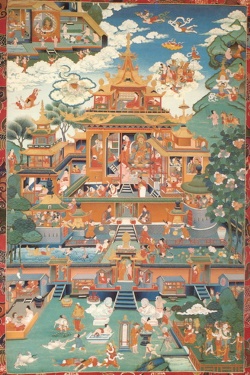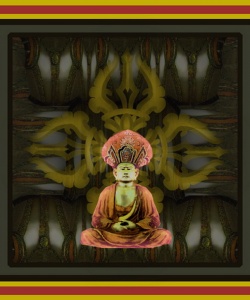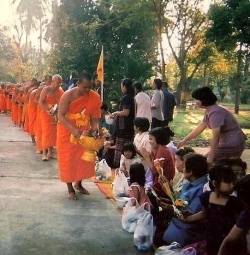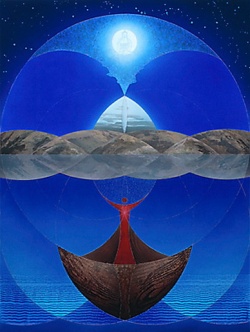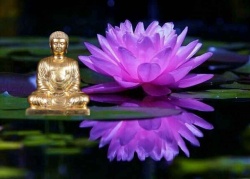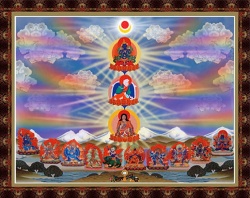Difference between revisions of "The History and Tradition of Korean Seon"
(Created page with " The History and Tradition of Korean Seon The Arrival of Seon and the Acceptance of Patriarchal Seon The Ganhwa Seon of Korea is a mainstream lineage of P...") |
|||
| (3 intermediate revisions by the same user not shown) | |||
| Line 1: | Line 1: | ||
| + | <nomobile>{{DisplayImages|1247|1236|3502|1171|3836|2629|1212}}</nomobile> | ||
| − | The [[History and Tradition of Korean Seon]] | + | |
| + | |||
| + | |||
| + | |||
| + | ===The [[History and Tradition of Korean Seon]]=== | ||
The [[Arrival of Seon]] and the [[Acceptance of Patriarchal Seon]] | The [[Arrival of Seon]] and the [[Acceptance of Patriarchal Seon]] | ||
| Line 18: | Line 23: | ||
From this it is clear that the [[Jogyejong]] has continued to maintain the {{Wiki|mainstream}} [[lineage of Patriarchal Seon]] in its true [[state]]. | From this it is clear that the [[Jogyejong]] has continued to maintain the {{Wiki|mainstream}} [[lineage of Patriarchal Seon]] in its true [[state]]. | ||
| − | The [[ancestor]] of [[Jogyejong]], | + | The [[ancestor]] of [[Jogyejong]], [[National Teacher Do-ui]] received the [[Seon Dharma]] from [[Xitang Zhizang]] (735-814) in the fourth generation from [[Huineng]]. |
| − | {{Wiki|National Teacher}} [[Do-ui]] worshipped and consulted [[Zhizang]] as his [[master]], dispelled the ball of [[doubt]] he had amassed and finally overcame the indigestion that blocked his [[enlightenment]]. [[Zhizang]], [[seeing]] this, just as if he had picked out a beautiful [[jade]] from among the pebbles or a {{Wiki|pearl}} from the oyster shell, was [[happy]] and said, “Truly if I do not transmit the [[Dharma]] to this man then to whom would I transmit it?” (Jodangjip 17). | + | {{Wiki|National Teacher}} [[Do-ui]] worshipped and consulted [[Zhizang]] as his [[master]], dispelled the ball of [[doubt]] he had amassed and finally overcame the indigestion that blocked his [[enlightenment]]. |
| + | |||
| + | [[Zhizang]], [[seeing]] this, just as if he had picked out a beautiful [[jade]] from among the pebbles or a {{Wiki|pearl}} from the oyster shell, was [[happy]] and said, “Truly if I do not transmit the [[Dharma]] to this man then to whom would I transmit it?” (Jodangjip 17). | ||
| − | In the [[Goryeo period]], with the advent of the [[Cheontae]] (Chi. [[Tientai]]) School that had the powerful backing of the {{Wiki|royal}} {{Wiki|clan}}, the [[Seon School]] shrank somewhat. Approaching the twelfth century, while consolidating the School, it proceeded [[to build]] a new foundation. {{Wiki|National Teacher}} Won-eung Hag-il (1052-1144) of the Gaji Mountain Gate and {{Wiki|National Teacher}} Daegam Tanyeon (1070-1159) of the Sa-gul Mountain Gate acted vigorously to restore the [[Seon School]]. Moreover, [[Layman]] Yi Jahyeon (1061-1125), who had extensive connections with the [[Seon | + | In the [[Goryeo period]], with the advent of the [[Cheontae]] (Chi. [[Tientai]]) School that had the powerful backing of the {{Wiki|royal}} {{Wiki|clan}}, the [[Seon School]] shrank somewhat. Approaching the twelfth century, while consolidating the School, it proceeded [[to build]] a new foundation. |
| + | |||
| + | {{Wiki|National Teacher}} Won-eung Hag-il]] (1052-1144) of the [[Gaji Mountain Gate]] and {{Wiki|National Teacher}} [[Daegam Tanyeon]] (1070-1159) of the [[Sa-gul Mountain Gate]] acted vigorously to restore the [[Seon School]]. | ||
| + | |||
| + | Moreover, [[Layman]] [[Yi Jahyeon]] (1061-1125), who had extensive connections with the [[Seon monks]] and who at that time exercised huge influence on the [[Seon]] [[thought]] of the [[Goryeo]], [[initiated]] the flowering of an invigorating layperson’s [[Buddhism]]. | ||
| − | The [[Acceptance | + | |
| + | |||
| + | ===The [[Acceptance and Consolidation of Ganhwa Seon]]=== | ||
| − | In the period of {{Wiki|military}} dominance in the [[Goryeo]], with the advent of [[Seon]] [[ | + | |
| + | |||
| + | In the period of {{Wiki|military}} dominance in the [[Goryeo]], with the advent of [[Seon Master]] [[Bojo Jinul]] (1158-1210), the [[Seon]]-style rose strongly once again. | ||
| + | |||
| + | At [[Suseonsa]] ([[Cultivation of Seon Society]] – today’s [[Songgwang-sa Monastery]]), {{Wiki|National Teacher}}[[ Bojo]] developed the [[Jeonghye Gyeolsa]] that was a {{Wiki|movement}} for the joint [[practice of meditation]] and [[wisdom]], and [[meditation]] practitioners [[gathered]] there from all over. | ||
| + | |||
| + | Then, for the first time, the [[Ganhwa Seon]] method established by [[Dahui]] (1089-1163) was introduced into [[Korea]] by [[Bojo]]. | ||
| + | |||
| + | The {{Wiki|National Teacher}} [[offered]] [[Ganhwa Seon]] for the practitioners of outstanding ability. | ||
| − | However, the [[person]] who genuinely accepted | + | However, the [[person]] who genuinely accepted [[ganhwa Seon]] into [[Goryeo Buddhism]] was {{Wiki|National Teacher}} [[Jin-gak Hyesim]] (1178-1234). |
| + | |||
| + | [[Seon Master]] [[Hyesim]] compiled the [[Seonmun yeomsong]], the very first collection of [[gongan]] (Jap. [[koan]]) in [[Korea]]. | ||
| + | |||
| + | This collection of [[gongan]] opened up a concrete [[path]] for practitioners to study ([[gongbu]] or [[concentrated]] [[effort]]) [[hwadu]]. | ||
| + | |||
| + | Moreover, [[Hyesim]] clarified in detail the concrete troubles and symptoms that can occur when studying, and elucidated the topic of the [[hwadu]] of the [[character]] “no” (the story of a {{Wiki|dog}} having no [[Buddha-nature]]). | ||
| − | After [[Seon | + | After [[Seon Master]] [[Hyesim]], the [[Ganhwa Seon]] method of practice and style was continued through sixteen national [[teachers]] of [[Suseonsa]]. |
| + | |||
| + | Of course, even in the period while they were active, the practice method of [[Ganhwa Seon]] entered [[Goryeo]] from [[China]] several times. | ||
| − | In 1270, the {{Wiki|military}} regime collapsed and Suseonsa fell to a low ebb, but the current of | + | In 1270, the {{Wiki|military}} regime collapsed and [[Suseonsa]] fell to a low ebb, but the current of [[Ganhwa Seon]] was renewed by [[Seon Master]] [[Iryeon]] (1200-1289) who consolidated the [[Seon]] style. |
| + | |||
| + | Around this time, many [[Seon monks]] of the [[Goryeo]] entered into Yuan [[China]] in active pursuit of the [[Dharma]], and through them many [[Seon]] texts and new [[Seon]] methods were introduced, and so the [[Goryeo Seon School]] encountered a new phase. | ||
| − | The [[Development | + | |
| + | |||
| + | ===The [[Development of Ganhwa Seon and its Complete Consolidation]]=== | ||
| − | The firm establishment of | + | |
| + | |||
| + | The firm establishment of [[Ganhwa Seon]] in [[Korea]] was accomplished by the [[activities]] of three [[teachers]] at the end of the [[Goryeo]]. | ||
| + | |||
| + | They were [[Seon masters]] [[Taego Bou]] (1301-1381), [[Naong Hye-geun]] (1320-1376) and [[Baeg-un Gyeonghan]] (1299-1375). | ||
| + | |||
| + | They all went to [[China]], and through their exchanges with genuine [[lineage teachers of the Seon Gate]], after inheriting the correct [[Dharma lineage]] of the [[Linji]] Branch, they returned to [[Goryeo]]. | ||
| + | |||
| + | In this way these three [[teachers]], after being [[enlightened]] to the [[teaching]] of [[Chan Master]] [[Mengshan]] of [[Yuan]] [[China]], who had freshly formed the new [[Seon]] style of the [[Seon Gate of Goryeo]], they sought out the true [[teachers]] of the [[lineage]] (literally, [[lineage masters]] of original complexion), received their {{Wiki|seal}} of approval, and established a strict [[tradition]]. | ||
| − | Although it is a fact that [[Seon | + | Although it is a fact that [[Seon masters]] [[Naong Hyegeun]] and [[Baeg-un Gyeonghan’s]] [[activities]] were outstanding, it was rather {{Wiki|National Teacher}} [[Taego Bou]] who spread [[Ganhwa Seon]] widely at the end of the [[Goryeo]] and firmly established it. |
| + | |||
| + | {{Wiki|National Teacher}} [[Bou]] argued that one transcended the [[Buddha]] through the house style of one’s [[own]] [[lineage teacher]] (literally, [[lineage master]] who originally shared in [[enlightenment]]), and as the [[teaching of Seon]] that passes over the [[patriarchs]] says, | ||
| + | |||
| + | “Even though one has all the teachings of the [[Tripitaka]], the 1,700 [[gongans]], the shouts of [[Linji]] or the blows of [[Deshan]], from the viewpoint of the original [[teacher of the lineage]] it is all in vain.” | ||
| − | The {{Wiki|National Teacher}} [[taught]] that one practice | + | The {{Wiki|National Teacher}} [[taught]] that one practice [[Ganhwa Seon]], investigate the [[hwadu]] and try not to interrupt [[doubt]], and after conquering the [[hwadu]], one seeks out one’s [[true lineage]] [[teacher]] and has him confirm one’s [[enlightened state]]. |
| + | |||
| + | That is, [[Seon Master]] [[Taego]] clearly established a [[Ganhwa Seon practice]] system in which one investigated the [[hwadu]], and after [[enlightenment]], sought out one’s [[true lineage]] [[teacher]] and asked him to [[judge]] if it was truly [[enlightenment]] or not. | ||
| − | The [[reason]] {{Wiki|National Teacher}} [[Taego Bou]] is venerated as the restoration [[patriarch | + | The [[reason]] {{Wiki|National Teacher}} [[Taego Bou]] is venerated as the restoration [[patriarch of Korean Buddhist Jogye order]] is because he firmly established such a systematic practice of [[Ganhwa Seon]], and because he received and brought the {{Wiki|mainstream}} [[lineage of Linji]] (Kor. [[Imje]]) [[Seon]] from [[China]], and because that [[Dharma-lineage]] has passed down through {{Wiki|Joseon}} [[Buddhism]] without break to the {{Wiki|present}} day. |
| − | The [[Transmission | + | |
| + | |||
| + | ===The [[Transmission of Ganhwa Seon in the Joseon period]] and the [[Revival of Ganhwa Seon in Recent Times]]=== | ||
| − | The | + | |
| + | |||
| + | The [[Ganhwa Seon Dharma]] was fully consolidated in [[Korea]] by {{Wiki|National Teacher}} [[Bou]], and through his agency occupied a firm place as the leading method of practice in [[Korean Buddhism]]. | ||
| + | |||
| + | [[Bou’s]] [[Seon lineage]] was continued by [[Seon masters]] [[Hwan-am Honsu]] (1320-1392), [[Gu-gok Gag-un]], [[Byeoggye Jeongsim]], [[Byeoksong Ji-eom]] (1464-1534), [[Buyong Yeonggwan]] (1485-1571), when it formed the two mountain branch [[lineages of Seon masters]] [[Cheongheo Hyujeong]] (1520-1604) and [[Buhyu Seonsu]] (1543-1615). | ||
| − | In [[Seon]] [[ | + | In [[Seon Master]] [[Seosan]] [[Hyujeong’s school]], the two great [[masters]] [[Pyeonyang Eon-gi]] (1581-1644) and [[Sa-myeong Yujeong]] (1544-1610) appeared, and of them, the faction of [[Seon aster]] [[Pyeonyang Eon-gi]] flourished in later times. |
| + | |||
| + | This [[latter]] [[Seon lineage]] was continued by [[masters]] [[Pungdam Uisim]] (1592-1655), [[Woldam Seoljye]] (1632-1704) and [[Hwanseong Jian]] (1664-1729). | ||
| − | In recent times, [[Seon]] [[ | + | In recent times, [[Seon Masters]] [[Gyeongheo Seong-u]] (1846-1912) and [[Yongseong Chinjong]] (1864-1940) greatly promoted the [[Ganhwa Seon]] style. |
| + | |||
| + | [[Gyeongheo]] succeeded to the [[Dharma]] of [[Seon Master]] [[Yong-am Hye-eon]]. | ||
| + | |||
| + | The advent of [[Gyeongheo]] was the direct occasion for the revival of the [[Seon]] style of [[Ganhwa Seon]] that had been dying out. | ||
| + | |||
| + | [[Gyeongheo’s]] [[disciples]] were [[Suwol]] (1855-1928), [[Hyewol]] (1855-1928), [[Man-gong]] (1871-1946) and [[Han-am]] (1876-1951) among others. | ||
| + | |||
| + | [[Seon Master]] [[Yeongseong]] succeeded to the [[Dharma lineage]] of [[Hwanseong Jian]]. | ||
| + | |||
| + | In [[Ganhwa Seon]] what is valued above all else is the [[Dharma]]. | ||
| + | |||
| + | So after [[Hwanseong]], the isolated [[lineage]] school was reactivated due to them and has been carried on till the {{Wiki|present}} day. | ||
| + | |||
| + | Their [[Seon]] style is a line of [[Ganhwa Seon]] that has its basis fully in [[Patriarchal Seon]]. | ||
{{R}} | {{R}} | ||
http://www.koreanbuddhism.net/bbs/board.php?bo_table=3020&wr_id=62 | http://www.koreanbuddhism.net/bbs/board.php?bo_table=3020&wr_id=62 | ||
[[Category:Korean Seon]] | [[Category:Korean Seon]] | ||
Latest revision as of 04:38, 13 March 2016
The History and Tradition of Korean Seon
The Arrival of Seon and the Acceptance of Patriarchal Seon
The Ganhwa Seon of Korea is a mainstream lineage of Patriarchal Seon that accepted entirely the current of Patriarchal Seon established by the Sixth Patriarch Huineng.
The Seon Dharma first entered Korea at the end of the Silla and start of the Goryeo dynasties, when monks who were foreign students seeking the Dharma in the Tang Dynasty received the Dharma from China and began to disseminate it in Korea.
Most of them received the Seon Dharma from Seon Master Huineng’s disciples, and they formed the Nine Mountain Seon Schools (kusan Seonmun).
By the Goryeo period, these Nine Mountain Seon Schools were collectively called Jogyejong, which was the Seon School that received the Seon Dharma of Seon Master Huineng.
The school name, “Jogyejong” of the Dae Han Bulgyo Jogyejong is derived from the name of the mountain where Seon Master Huineng resided and unfolded the Seon Dharma of sudden enlightenment.
From the time of the Tang and Song dynasties, Seon Master Huineng was called Caoqi Huineng (Kor. Jogye Hyeneung).
From this it is clear that the Jogyejong has continued to maintain the mainstream lineage of Patriarchal Seon in its true state.
The ancestor of Jogyejong, National Teacher Do-ui received the Seon Dharma from Xitang Zhizang (735-814) in the fourth generation from Huineng.
National Teacher Do-ui worshipped and consulted Zhizang as his master, dispelled the ball of doubt he had amassed and finally overcame the indigestion that blocked his enlightenment.
Zhizang, seeing this, just as if he had picked out a beautiful jade from among the pebbles or a pearl from the oyster shell, was happy and said, “Truly if I do not transmit the Dharma to this man then to whom would I transmit it?” (Jodangjip 17).
In the Goryeo period, with the advent of the Cheontae (Chi. Tientai) School that had the powerful backing of the royal clan, the Seon School shrank somewhat. Approaching the twelfth century, while consolidating the School, it proceeded to build a new foundation.
National Teacher Won-eung Hag-il]] (1052-1144) of the Gaji Mountain Gate and National Teacher Daegam Tanyeon (1070-1159) of the Sa-gul Mountain Gate acted vigorously to restore the Seon School.
Moreover, Layman Yi Jahyeon (1061-1125), who had extensive connections with the Seon monks and who at that time exercised huge influence on the Seon thought of the Goryeo, initiated the flowering of an invigorating layperson’s Buddhism.
The Acceptance and Consolidation of Ganhwa Seon
In the period of military dominance in the Goryeo, with the advent of Seon Master Bojo Jinul (1158-1210), the Seon-style rose strongly once again.
At Suseonsa (Cultivation of Seon Society – today’s Songgwang-sa Monastery), National TeacherBojo developed the Jeonghye Gyeolsa that was a movement for the joint practice of meditation and wisdom, and meditation practitioners gathered there from all over.
Then, for the first time, the Ganhwa Seon method established by Dahui (1089-1163) was introduced into Korea by Bojo.
The National Teacher offered Ganhwa Seon for the practitioners of outstanding ability.
However, the person who genuinely accepted ganhwa Seon into Goryeo Buddhism was National Teacher Jin-gak Hyesim (1178-1234).
Seon Master Hyesim compiled the Seonmun yeomsong, the very first collection of gongan (Jap. koan) in Korea.
This collection of gongan opened up a concrete path for practitioners to study (gongbu or concentrated effort) hwadu.
Moreover, Hyesim clarified in detail the concrete troubles and symptoms that can occur when studying, and elucidated the topic of the hwadu of the character “no” (the story of a dog having no Buddha-nature).
After Seon Master Hyesim, the Ganhwa Seon method of practice and style was continued through sixteen national teachers of Suseonsa.
Of course, even in the period while they were active, the practice method of Ganhwa Seon entered Goryeo from China several times.
In 1270, the military regime collapsed and Suseonsa fell to a low ebb, but the current of Ganhwa Seon was renewed by Seon Master Iryeon (1200-1289) who consolidated the Seon style.
Around this time, many Seon monks of the Goryeo entered into Yuan China in active pursuit of the Dharma, and through them many Seon texts and new Seon methods were introduced, and so the Goryeo Seon School encountered a new phase.
The Development of Ganhwa Seon and its Complete Consolidation
The firm establishment of Ganhwa Seon in Korea was accomplished by the activities of three teachers at the end of the Goryeo.
They were Seon masters Taego Bou (1301-1381), Naong Hye-geun (1320-1376) and Baeg-un Gyeonghan (1299-1375).
They all went to China, and through their exchanges with genuine lineage teachers of the Seon Gate, after inheriting the correct Dharma lineage of the Linji Branch, they returned to Goryeo.
In this way these three teachers, after being enlightened to the teaching of Chan Master Mengshan of Yuan China, who had freshly formed the new Seon style of the Seon Gate of Goryeo, they sought out the true teachers of the lineage (literally, lineage masters of original complexion), received their seal of approval, and established a strict tradition.
Although it is a fact that Seon masters Naong Hyegeun and Baeg-un Gyeonghan’s activities were outstanding, it was rather National Teacher Taego Bou who spread Ganhwa Seon widely at the end of the Goryeo and firmly established it.
National Teacher Bou argued that one transcended the Buddha through the house style of one’s own lineage teacher (literally, lineage master who originally shared in enlightenment), and as the teaching of Seon that passes over the patriarchs says,
“Even though one has all the teachings of the Tripitaka, the 1,700 gongans, the shouts of Linji or the blows of Deshan, from the viewpoint of the original teacher of the lineage it is all in vain.”
The National Teacher taught that one practice Ganhwa Seon, investigate the hwadu and try not to interrupt doubt, and after conquering the hwadu, one seeks out one’s true lineage teacher and has him confirm one’s enlightened state.
That is, Seon Master Taego clearly established a Ganhwa Seon practice system in which one investigated the hwadu, and after enlightenment, sought out one’s true lineage teacher and asked him to judge if it was truly enlightenment or not.
The reason National Teacher Taego Bou is venerated as the restoration patriarch of Korean Buddhist Jogye order is because he firmly established such a systematic practice of Ganhwa Seon, and because he received and brought the mainstream lineage of Linji (Kor. Imje) Seon from China, and because that Dharma-lineage has passed down through Joseon Buddhism without break to the present day.
The Transmission of Ganhwa Seon in the Joseon period and the Revival of Ganhwa Seon in Recent Times
The Ganhwa Seon Dharma was fully consolidated in Korea by National Teacher Bou, and through his agency occupied a firm place as the leading method of practice in Korean Buddhism.
Bou’s Seon lineage was continued by Seon masters Hwan-am Honsu (1320-1392), Gu-gok Gag-un, Byeoggye Jeongsim, Byeoksong Ji-eom (1464-1534), Buyong Yeonggwan (1485-1571), when it formed the two mountain branch lineages of Seon masters Cheongheo Hyujeong (1520-1604) and Buhyu Seonsu (1543-1615).
In Seon Master Seosan Hyujeong’s school, the two great masters Pyeonyang Eon-gi (1581-1644) and Sa-myeong Yujeong (1544-1610) appeared, and of them, the faction of Seon aster Pyeonyang Eon-gi flourished in later times.
This latter Seon lineage was continued by masters Pungdam Uisim (1592-1655), Woldam Seoljye (1632-1704) and Hwanseong Jian (1664-1729).
In recent times, Seon Masters Gyeongheo Seong-u (1846-1912) and Yongseong Chinjong (1864-1940) greatly promoted the Ganhwa Seon style.
Gyeongheo succeeded to the Dharma of Seon Master Yong-am Hye-eon.
The advent of Gyeongheo was the direct occasion for the revival of the Seon style of Ganhwa Seon that had been dying out.
Gyeongheo’s disciples were Suwol (1855-1928), Hyewol (1855-1928), Man-gong (1871-1946) and Han-am (1876-1951) among others.
Seon Master Yeongseong succeeded to the Dharma lineage of Hwanseong Jian.
In Ganhwa Seon what is valued above all else is the Dharma.
So after Hwanseong, the isolated lineage school was reactivated due to them and has been carried on till the present day.
Their Seon style is a line of Ganhwa Seon that has its basis fully in Patriarchal Seon.
Source
http://www.koreanbuddhism.net/bbs/board.php?bo_table=3020&wr_id=62
